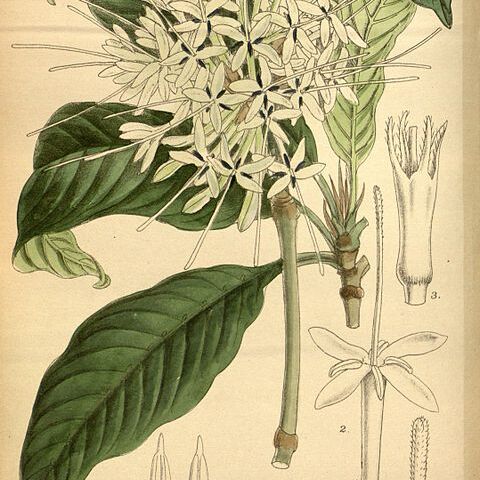Shrubs, small trees, or infrequently subshrubs, unarmed. Raphides absent. Leaves opposite or rarely whorled, usually with bacterial nodules and/or domatia in abaxial vein axils; stipules generally persistent, shortly united around stem, triangular, often aristate, often sericeous adaxially. Inflorescences terminal on principal stems, terminal on reduced lateral stems and appearing axillary, or rarely truly axillary, cymose to corymbiform, many flowered, sessile to pedunculate, bracteate with bracts often fused in pairs. Flowers pedicellate or sessile, bisexual, monomorphic, fragrant, with secondary pollen presentation. Calyx limb truncate or 4(or 5)-lobed. Corolla white to cream [or rarely red], salverform with tube slender, inside glabrous or pubescent in throat; lobes 4, convolute in bud. Stamens 4(or 5), inserted in corolla throat, exserted or included; filaments short; anthers dorsifixed near base, sometimes becoming twisted with age. Ovary 2-celled, ovules 1(or 2) in each cell on axile placentas attached at top of septum; stigma restricted to terminal portion of thickened style, very shortly 2-lobed with lobes erect, exserted. Fruit black and often shiny or infrequently white, red, or blue, drupaceous, thinly fleshy, globose to ovoid, with calyx limb persistent or deciduous; pyrenes 2, 1-celled, each with 1 seed, plano-convex or concavo-convex, papery; seeds medium-sized, ellipsoid, discoid, or plano-convex; testa membranous; endosperm corneous; embryo dorsal, curved; cotyledons leaflike; radicle hypogeous.
Leaves opposite, occasionally ternate, sessile or petiolate, sometimes those on inflorescence-supporting branches differ from those on the main stem or vegetative shoots, being smaller with shorter petioles or anisophyllous, sometimes shape may differ according to position of the branches (see note after P. gardeniifolia); blades sometimes with domatia present in the nerve axils beneath and usually with blackish dot-like elliptic or linear bacterial nodules scattered on the blade or arranged along the midrib; stipules with a triangular to truncate limb, connate at the base or for up to the entire length, bearing a subulate arista, less often a short mucro or a keeled lobe, sometimes with silky hairs within.
Inflorescences sessile or subsessile with (1)few–many flowers in a very lax to capitate corymbose arrangement, terminal on main and lateral leafy branches or on short leafless spurs or branches (which in the absence of corky bark can resemble axillary pedunculate corymbs), occasionally such inflorescence-supporting branches entirely suppressed giving the inflorescence an axillary appearance (TAB. 108); bracts connate, stipule-like; bracteoles free, usually small, sometimes absent.
Ovary small, 2-locular (?very rarely 4-locular); placentas fleshy, pendulous from the upper part of the septum; ovules solitary or rarely paired, immersed or partially immersed in the cup-like arrangement of tissues; style long-exserted, slender, glabrous to subglabrous, sometimes the exserted portion pubescent, the upper part (pollen presenter) thickened, club-shaped, with 8 shallow ribs, always shortly hairy; stigmatic surface confined to the bidentate apex.
Corolla white to cream-coloured or greenish-white, infrequently yellow or rarely red (P. canescens DC. from Angola and Dem. Rep. Congo); tube cylindrical to funnel-shaped (but never greatly widened at the throat), bearded or pubescent to glabrous in the throat; lobes lanceolate, oblong or ovate, contorted in bud.
Calyx tube turbinate to campanulate; limb persistent or deciduous, rarely accrescent; limb-tube very short or long, often wider than the tube; lobes short to long, ovate (often overlapping) to triangular, lanceolate to subulate, often separated by sinuses or occasionally absent (TAB. 109).
Stamens attached at the mouth of the tube, exserted and spreading or reflexed in mature flower; filaments very short; anthers dorsifixed near the base, linear to oblong, ± equalling the corolla lobes in length, apiculate and sagittate, very often twisted when dehisced.
Seeds 2 (or rarely 1 by abortion), attached to the centre of the septum, hemispherical with a wide circular excavation in the centre of the ventral face, convex dorsal face usually rugulose; endosperm always entire and horny; embryo small, dorsal, curved.
Fruit a drupe, frequently black and shiny, rarely white or coloured, spherical, slightly 2-lobed, scarcely fleshy, containing 1(2) chartaceous pyrenes.
Shrubs or small trees, occasionally subshrubs with woody underground stems.
Flowers hermaphrodite, always 4-merous.
Disk annular, fleshy.

